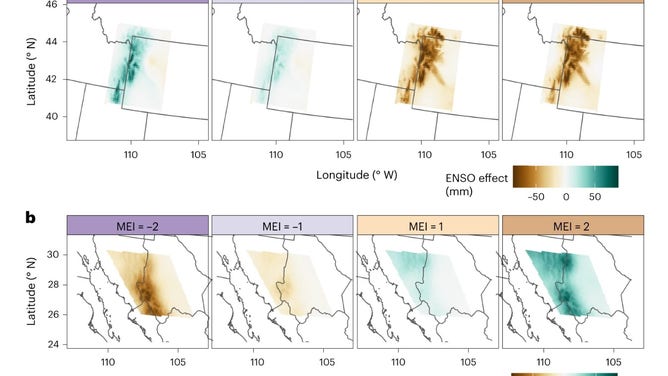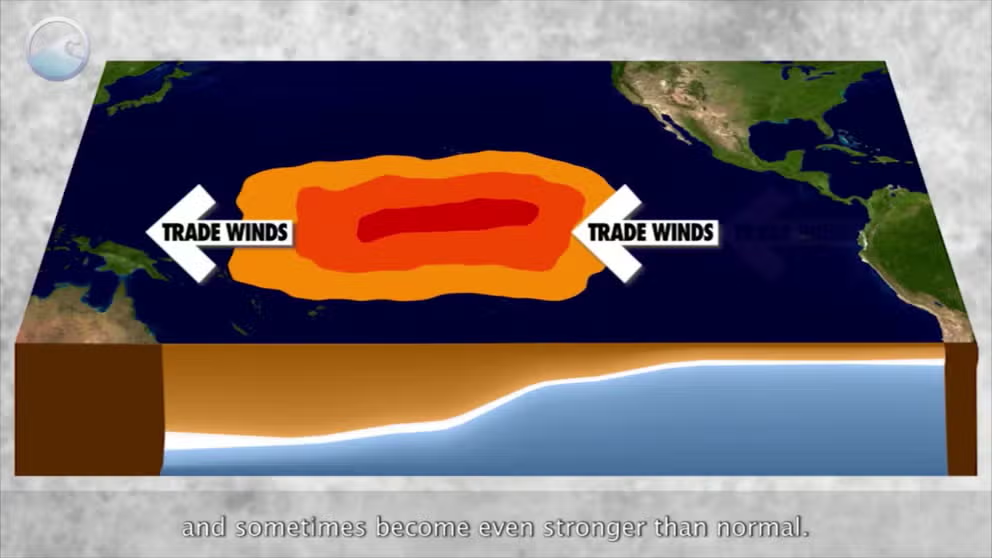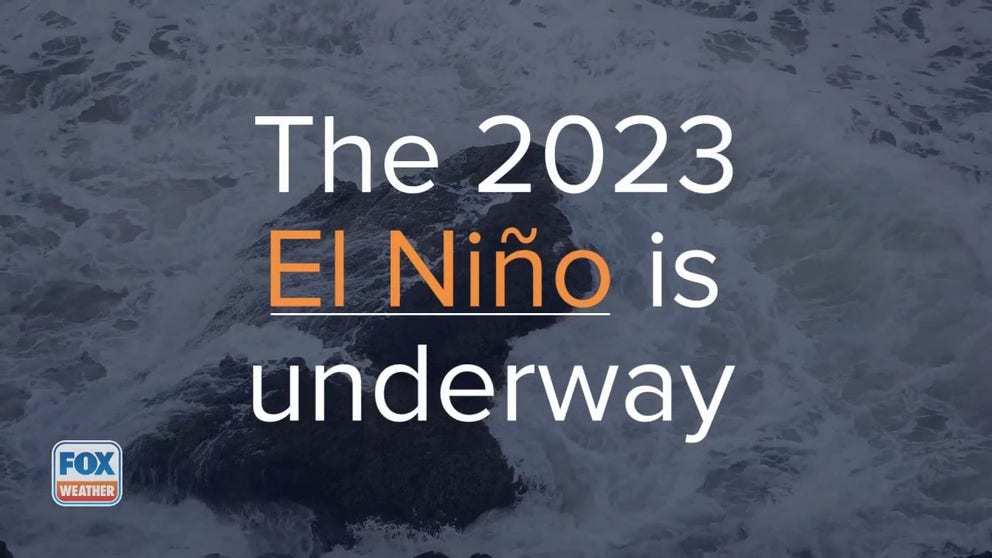El Nino doesn’t treat America’s western mountains the same, study finds
A new study using over 150 years of observational data in the Intermountain West has unearthed important clues into how El Niño and La Niña interact with various elevations, providing critical insight for water managers to plan ahead for the region's notorious droughts.
The meaning of El Nino and La Nina
The status of whether the world is being impacted by an El Nino or a La Nina is determined by water temperatures in the central and eastern Pacific. (NOAA)
More accurate forecasts of El Niño-"induced" mountain snow is key for water managers to get through drought years, scientists claim, and a new study may have unearthed additional clues into how El Niño patterns can influence precipitation trends in the Intermountain West and the region's water supply.
"If you can predict how much precipitation you’ll have in the winter, you’ll have a good sense of what your summer dry period will look like in terms of your water allocation," James Stagge, study lead author and Professor at The Ohio State University, said in a press release announcing the study's results.
"Anything we can do to improve our ability to predict how much water we’ll get during this critical period allows cities, farmers, water managers and member states of the Colorado River Compact to prepare for upcoming drought and potentially start to go into conservation ahead of time so they’re not caught flat-footed," he continued.
LONG TERM ‘ISN’T LOOKING GOOD' FOR LAKE MEAD AND LAKE POWELL, AMERICA'S LARGEST RESERVOIRS

File: Swimmers survey the wreckage of a boat that was once sunken in Lake Mead, but appeared above the surface in May 2022 because of dropping water levels.
(Travis Pardee / FOX Weather)
The El Niño boost
ENSO stands for the El Niño/Southern Oscillation. El Niño generally means wetter-than-average winters in the Southwest, northwestern New Mexico and the Gulf Coast as more moisture is funneled along the U.S.-Mexico border, along with an increased number of atmospheric rivers. Meanwhile, precipitation trends are drier in the northern mountains. The pattern reverses during La Niña winters, during which winter precipitation has tended to increase in northern Utah and Wyoming.
This winter is not only in the El Niño pattern; it is a strong-to-super El Niño pattern, which will amp up the effects even more.
Winter is the Intermountain West's rainy season, while summers are very dry. But high elevations on the west side of some western mountains can see two to six times more precipitation during El Niño years as the jet stream takes direct aim.
"All the rain falls on the west side and then by the time it gets to the east side of the mountains, there’s no more moisture to fall," Stagge said. "Add in the effect of ENSO, and it’s just like a multiplier, so the wet side gets a lot wetter during El Niño in the south."
But rain shadowing can leave the eastern sides still high and dry – a drying process that can be enhanced during strong El Niño events.
STRONG EL NINO WINTER: WHAT KIND OF WEATHER YOU CAN EXPECT
What is an El Nino weather pattern
El Ninos are known to produce extreme weather around the globe. The world entered an El Nino in June 2023, and events are known to produce both good and bad impacts.
Research team collected data back to 1871
To get better details on how the ENSO cycle interacts with different elevations, the team collected rain and snowfall data across the Intermountain West and looked at amounts by elevation and location, going back 150 years.
Stagge said his team didn't use climate models or averages. Instead, they studied observations that provided more precise information on where and how much precipitation fell in neutral years, La Niña years and El Niño years according to elevation. In this way, it links actual precipitation levels to not only a specific geographic location but its elevation as well, Stagge said.
WHAT ARE TRADE WINDS AND WESTERLIES?

The U.C. Berkeley Central Sierra Snow Lab after 16 feet of snow this December.
(U.C. Berkeley Central Sierra Snow Lab / FOX Weather)
Elevation is key because as moist air is forced up and over a mountain range, it cools as air temperatures decrease with height. Cool air holds less water vapor, and the excess condenses out into clouds and then precipitation. Meteorologists call it orographic lifting. That is why rain and snow fall on the western side of mountain ranges and parch the east side.
Due to the placement of mountain ranges, not all states get the same El Niño boost, they found. Utah and Wyoming actually saw more rain than average during the La Niña events and less than average during El Niño. New Mexico and Arizona saw increased precipitation during El Niño.
Scientists feel it is because winds hit California's Sierra Nevada Mountains first, drying out the air on the eastern side.
HIGH PRESSURE AND LOW PRESSURE DRIVE THE WEATHER

The brown shows the fewer than average mm of rain falling while the green is greater than average. A is the most impacted northern location while b is the most impacted southern location in Mexico. MEI -2 is strong La Niña, MEI-1 average La Niña, MEI 1 average El Niño and MEI 2 strong El Niño.
(Stagge et al. / FOX Weather)
The study also found that ENSO cycle doesn't affect the northern mountains quite the same way as the southern mountains.
In the southern mountains, researchers found rainfall is more sensitive to small changes in the El Niño patten. A slight increase or decrease in the strength of El Niño will have a corresponding change in expected precipitation.
Meanwhile, in the north, the change in precipitation doesn't react to small changes in ENSO. Instead, it works more "like a light switch," researchers noted. "It either happens or it doesn't."
"That may have to do with the complexity of the topography," Stagge said in the release. "In the south, the Sierra Nevadas are not blocking the air flow, like they are for Utah and Wyoming."
Stagge says the finding could have big implications for water managers across the region: Forecasts focusing on the strength of El Niño or La Niña are more informative in the north, while tracking small temperature change estimates in ENSO would be more useful in the south.
Western water managers face uphill battle of famine and feast
As generally the Intermountain West is dry with an average of just around 8-20 inches of annual rain, water managers need to plan for arid conditions.
"Much of western North America is classified as under extremely high water stress due to low annual precipitation … frequent multi-year droughts and a reliance on reservoirs to satisfy agricultural, municipal and ecological demands," wrote the authors. "In Mexico and the USA, 50.3 million and 50.9 million urban inhabitants face water scarcity for at least one month of the year, respectively, most of whom live in western states."
Between 1980 and 2022, drought cost the U.S. an estimated $309 billion, according to the study. That was 13% of all weather and climate disasters. In 2022, a Mexico reservoir was only at 17% of capacity, and officials warned of structure failure.
"The southwestern USA and Mexico are consistently identified as hotspots for decreasing precipitation trends during the last century and in future projections," the study states. "Situating these drying trends relative to pre-industrial climate has shown that recent decades are uniquely dry among the last millennium."

File: This aerial combination photo created on April 17, 2023, shows a car crossing the Enterprise Bridge at Lake Oroville in Oroville, California, on September 05, 2021 (top), and on April 16, 2023 (below).
(JOSH EDELSON/AFP / Getty Images)
ONGOING 22-YEAR DROUGHT IN WESTERN US IS DRIEST PERIOD IN OVER 1,200 YEARS, STUDY FINDS
But the study's authors hope this new data can help water managers better plan for the dry periods.
"Water is a determining factor in western North America. It drives the economy, it drives extremely large cities, and all of these stakeholders are concerned about it," Stagge said. "If we’re able to better understand or, in some cases, predict precipitation in this part of the world, then we have a better chance of preparing for water shortages."

